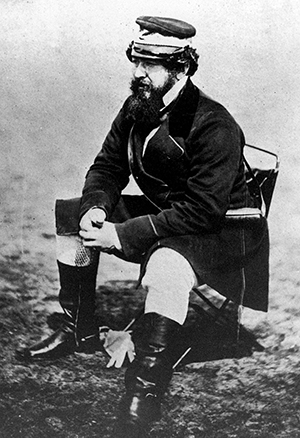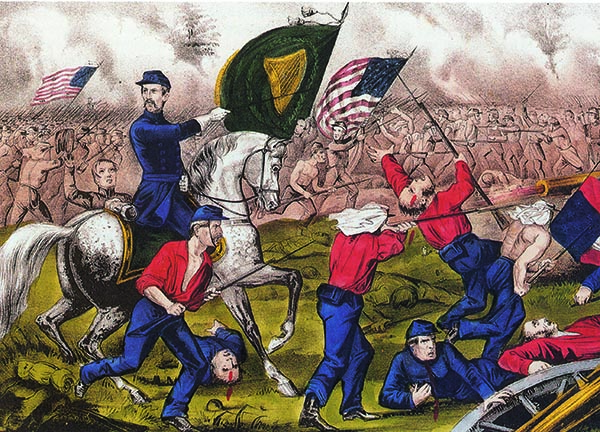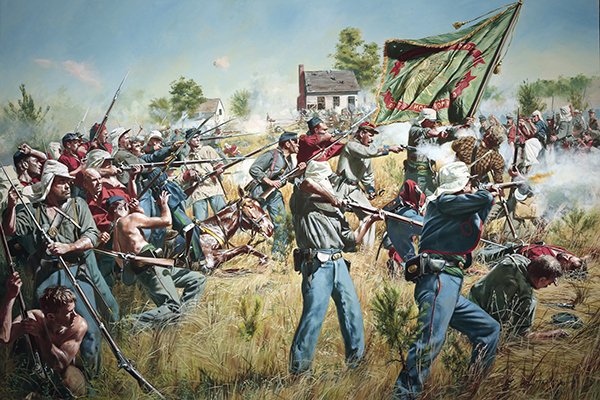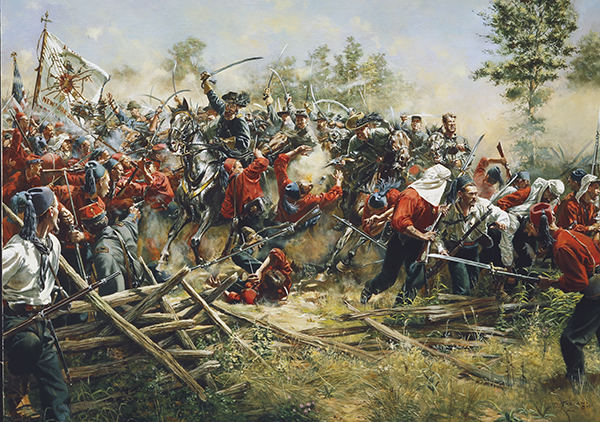‘Bull Run Russell’
Published in Features, Issue 1 (January/February 2020), Volume 28William Howard Russell at the First Battle of Bull Run, 1861.
By Royston Spears
Sir William Howard Russell, special correspondent of the London Times, is best known today for his unflinching reports of the Crimean War, but few people realise that he also witnessed the dramatic opening stages of the American Civil War, including the first great battle at Bull Run. He would later record his experiences in his 1863 book My diary North and South.

Above: William Howard Russell, Dublin-born London Times correspondent, photographed in the Crimea by Roger Fenton.
Background
Russell was born in Tallaght, Co. Dublin, in March 1820, and was educated at Trinity College, Dublin. In 1841 he joined his cousin, Robert Russell, in reporting on the Irish general election. The following year he was working as a teacher in London and also writing articles for The Times. His writing was much admired by the editor, John Thadeus Delane, and Russell became a full-time employee of the paper. In 1850 he was sent to cover the First Schleswig War (1848–52), and subsequently secured his reputation as a war correspondent during the Crimean War (1854–6).
Five years later, as the secession crisis in the United States threatened to become a civil war, Russell seemed the natural choice to report on events. On 3 March 1861 (the day before Abraham Lincoln’s inauguration) Russell left Cork aboard the steamship Arabia, arriving in New York on the 16th. On Monday 18th he decided to watch the St Patrick’s Day parade along Broadway. Here he was to see many of the men who would shortly fight at the First Battle of Bull Run (also known as First Manassas in the Confederacy). Among the parading regiments were the 69th New York State Militia. Russell noted that this Irish regiment had famously refused to parade for the prince of Wales during his recent visit to New York, and as a consequence their colonel, Michael Corcoran, was facing a court martial. Russell, however, was unimpressed by their appearance. He commented that ‘the Prince had no loss’, as the men were fine enough fellows ‘but looked not in the least like soldiers or militia’.
As the political situation in America deteriorated, Russell toured the states, familiarising himself with many of the leading figures on both sides. He met the South’s Gen. P.G.T. Beauregard and the North’s Gen. Irvin McDowell, and even the opposing presidents, Abraham Lincoln and Jefferson Davis. Of the two, he found Lincoln the more impressive figure and was struck by the great man’s ‘shrewdness, humour and natural sagacity’.
On 12 April 1861 the war, so long anticipated, finally erupted when Confederate artillery opened fire on the Union-held Fort Sumter in Charleston harbour. Over the following months both sides prepared themselves for the first major battle of the war.
The course of the battle
The newly formed Union and Confederate armies, which Lincoln had described as being ‘green alike’, eventually faced each other some 25 miles south-west of Washington DC, at a stream called Bull Run. The Confederates under Gen. Beauregard and Gen. Joseph Johnston held the south of the stream and the strategically important Manassas railroad junction, whilst Union troops under Gen. McDowell held the north and the settlement of Centreville. McDowell’s plan was to launch a diversionary attack across the stone bridge at Bull Run, whilst his main forces outflanked the Confederate army and attacked from the west. Early on the morning of Sunday 21 July 1861, Union troops under Brig. Gen. Daniel Tyler launched their diversionary attack against Col. Nathan Evans’s brigade. Evans, however, quickly received word by signal flag that an outflanking manoeuvre was being launched further west and moved most of his men to the nearby Matthews Hill to meet it. Despite putting up fierce resistance, Evans’s outnumbered men were soon forced to retreat, but with reinforcements rapidly arriving from Manassas, the Confederate army formed a new defensive position, a little further east, on Henry Hill. It was here, towards midday, that Brig. Gen. Thomas Jackson earned his legendary nickname. Whilst other Confederate brigades were breaking, Jackson’s men held firm, prompting Brig. Gen. Barnard Bee to shout: ‘Look! There stands Jackson like a stone wall. Rally behind the Virginians!’

Above: A Currier and Ives hand-coloured lithograph of Col. Michael Corcoran at the Battle of Bull Run, Virginia, 21 July 1861. (Yale University Art Gallery)
Union forces launched repeated attacks against Henry Hill in an attempt to break the Confederate line, and for many hours the battle swung back and forth. At times a Union victory seemed assured, but by the late afternoon both armies were exhausted. Crucially for the Confederacy, however, fresh troops were arriving from Manassas railway station and were now being put into the line. When Col. ‘Jeb’ Stuart’s cavalry launched a late afternoon attack on the Union forces below Henry Hill, he realised that victory was near. He urged the newly arrived troops of Brig. Gen. Kirby Smith and Col. Jubal Early to attack at once. Towards five o’clock the Union line retreated and and then broke.
Russell’s account of events
In My diary North and South Russell provided a fascinating account of the battle. Early on the morning of the 21st, he took a gig from Washington DC with his companion Mr Warre, a driver and a young attendant. After crossing the Long Bridge over the Potomac River, they headed south towards Bull Run. The countryside beyond Washington was quiet and few people were seen, except an occasional soldier. The roads south were badly damaged and rutted by the ‘gun-wheels, ammunition and commissariat wagons’ of McDowell’s army. At a little before nine, they heard the first booms of artillery fire in the distance (Russell’s watch had stopped, so he was forced to estimate the time). Russell ordered them on: ‘We shall be late! Drive on as fast as you can!’ Further along the road they met the 4th Pennsylvania Regiment, slowly making its way back northwards. Russell was puzzled and asked one of their officers why they were retreating. The officer said that the men’s enlistment papers had expired and they were now free from their obligations to the Union army: ‘We have had three months of this sort of work, and that’s quite enough of it’. Russell was shocked by the attitude of this officer, and his diary sarcastically describes the man’s words as ‘noble and patriotic’.
Towards noon, the driver stopped at Fairfax courthouse and watered the horses. In the distance the artillery and musket fire was becoming intense and Russell was keen to move on. Further south they encountered buggies filled with civilians, heading out to witness the battle, and by about two o’clock Russell’s party had halted at a hilltop near Centreville, where they sent the young attendant down to a nearby village to find supplies. Russell described the countryside ahead of him, where an unseen battle was now raging, as ‘One of the most agreeable displays of simple pastoral woodland scenery that could be conceived’. He observed the scene with his field glass and noted the rising smoke from massed muskets and the distinctive smoke rings of howitzer fire climbing above the trees. Since the Union baggage train was still halted on the road south of Centreville, he deduced that no great advance had been made. Around him civilians, including a lady with a pair of opera glasses, discussed the battle and speculated on what might be happening. Then a Union officer appeared, shouting: ‘We’ve whipped them on all points. We have taken their batteries. They are retreating as fast as they can, and we are after them.’ Russell described how the spectators cheered and Union congressmen shook hands with each other, whilst the Irish in the crowd ‘hurrahed wildly’. The predictions of a great Union victory were to prove premature, however. Eager to see what was happening, Russell decided to abandon his companions and their gig and ride towards the battle alone. The road was still congested with military vehicles, now heading towards Bull Run. After three or four miles of riding, Russell reached a bridge. Here he unexpectedly spotted some wagons heading north:

Above: New York’s Bravest by Don Troiani. The 69th New York State Militia and their comrades of the 11th New York Fire Zouaves engage in fierce fighting against Confederate troops on Henry Hill. The distinctive Irish flag at the centre of the action is that of the 69th. To the left is Thomas Francis Meagher, pointing his sword towards the colours as his horse is shot from under him. It was difficult to tell friend from foe at Bull Run. Both sides fought in a motley array of blue and grey uniforms and shirts of all colours. (Bridgeman Images)
‘My first impression was that the wagons were returning for fresh supplies of ammunition. But every moment the crowd increased, drivers and men cried out with the most vehement gestures, “Turn back! Turn back! We are whipped”.’
A wave of confusion spread through the entire Union column, and soon wagons which had been heading south were desperately attempting to turn in the narrow roads and make their way back towards Washington DC. A group of Union cavalrymen appeared, flourishing their sabres, and one of their officers shouted ‘Make way there for the general’ as they raced northwards. Russell decided to press on. He crossed the bridge, abandoned the congested road and made his way through the cornfields towards the battle. The ground was littered with ‘coats, blankets, firelocks, cooking tins, caps, belts, bayonets’. About half a mile further on he met a Union artillery battery, unlimbered and ready for action near a white house, with panting horses resting nearby. As Russell was asking one of the gunners to light his cigar, a loud burst of fire arose from the woods ahead. Shortly afterwards, a group of soldiers emerged from the trees. The artillery crew immediately swung their guns towards them and prepared to fire, when an officer or sergeant shouted: ‘Stop, stop! They are our own men’. Soon a whole battalion of Union troops had fled from the woods in ‘utmost disorder’, claiming that they were being pursued by Confederate cavalry. Russell’s experience of war led him to doubt these claims. He said that not even Napoleon’s great cavalry general Joachim Murat would have attempted to move cavalry over such ground.
After a couple of shells burst nearby, and with no prospect of getting any further, Russell decided to follow the tide northwards. At times the crowd of fleeing troops around him grabbed at his horse and stirrups, and he feared that he might be unseated. He tried to calm the men he met by saying, ‘There’s no enemy to pursue you. All the cavalry in the world could not get at you.’ But it was like talking to stones. As he neared Centreville, he saw a regiment, with artillery support, heading south to form a rearguard and prevent the Confederates from taking full advantage of the Union army’s rout. Russell realised that it was getting late and that there would probably be no more significant fighting. Being unable to find his companions and their gig in the chaos of retreat, he continued his ride north. It was just before eleven o’clock that evening when he crossed the Long Bridge and made his way to his lodgings in the capital.

Above: First at Manassas by Don Troiani. ‘Jeb’ Stuart’s Confederate First Virginia Cavalry charge the distinctive red-shirted New York Fire Zouaves in the late afternoon. The Fire Zouaves were composed largely of Irish immigrant firefighters, and their distinctive standard (with a ladder and a fireman’s helmet) can be seen to the left of the picture. (Bridgeman Images)
Russell is ostracised
Russell wrote a candid account of the shock Union defeat for The Times, in which he described the rout as a ‘miserable, causeless panic’. Inevitably, this made him very unpopular with many in the North. Everywhere he went he was taunted with shouts of ‘Bull Run Russell’. Unable to secure the necessary passes to follow the Union army, and facing death threats and a hostile Northern press, he eventually decided to head back to London in April 1862. He reported on several more wars, including the Zulu War of 1879, and was knighted in 1895. He died in 1907 and was given an impressive memorial at St Paul’s Cathedral in London, which eulogised him as ‘The first and greatest of war correspondents’.
Royston Spears is a schoolteacher in Cambridge, with a strong interest in military history.
FURTHER READING
A. Hankinson, First Bull Run 1861: the South’s first victory (London, 1990).
E.G. Longacre, The early morning of war: Bull Run, 1861 (Norman, 2014).
W.H. Russell, My diary North and South (Boston, 1863).
















